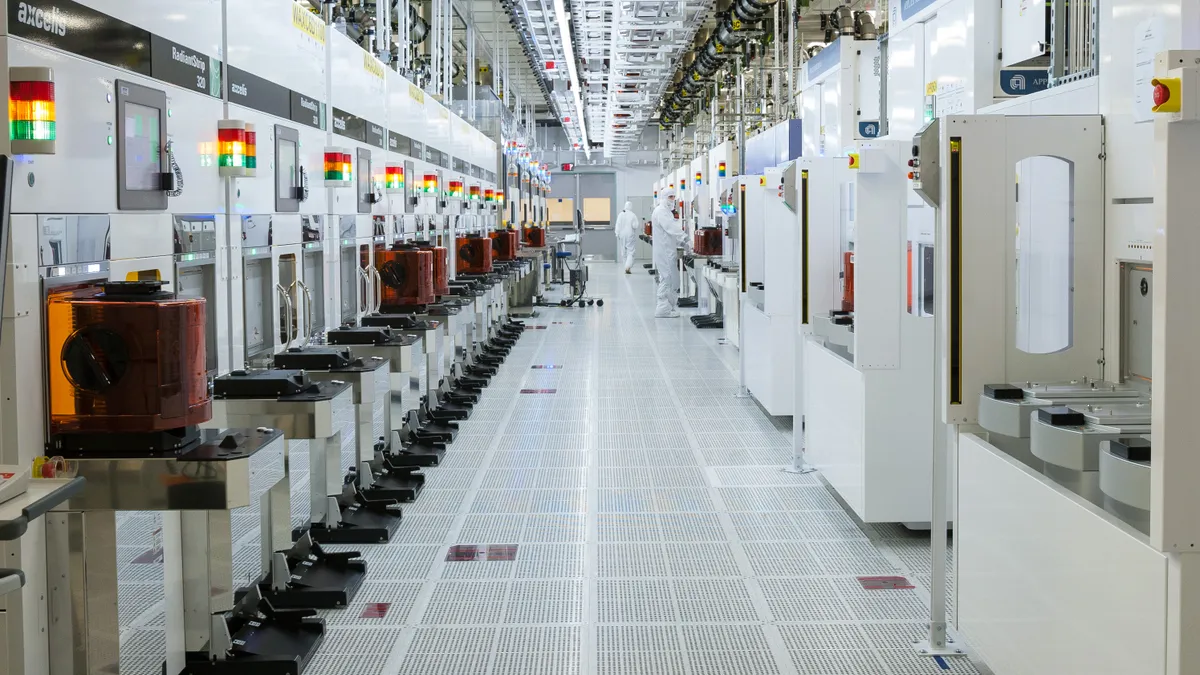MANASSAS, Va. — From the outside, Micron Technology Inc.'s Virginia manufacturing plant is unassuming.
While enormous, the generic, boxy architecture fails to hint at the ballet of machines whirring inside. There's no glimpse of the thousands of square feet of clean room attended by plastic suit-glad employees in the secure facility.
The only clue impressing the scale of the facility is the battery of heavy equipment working to expand the semiconductor manufacturing plant. The company plans to invest $3 billion by 2030, creating more than 1,000 jobs in the next 10 years.
Headquartered in Boise, Idaho, Micron is one of the largest semiconductor companies in the world and brought in $30.4 billion, up 50% year-over-year, according to its fiscal 2018 earnings report in September.
In the U.S., it's behind companies like Intel in terms of revenue, which brought in $70.8 billion in revenue in fiscal 2018, up 12% year-over-year, according to its year-end earnings report in January.
With 12 manufacturing sites globally, Micron has to keep pace with businesses' hunger for advanced memory technology.
In the early 2000s, the company's customers were PC-centric, with buyers from Dell and Lenovo. But smartphones, internet of things devices at the edge, cloud computing and data centers are driving increased memory demand.
The primary responsibility for the Manassas site is to make memory and storage products — DRAM, NAND and NOR — for automotive and industrial IoT, said Tim O'Brien, site director at Micron's Manassas facility, speaking in a media roundtable in June.
To expand its presence in the space, the company is investing in a global R&D center there.
Companies are eager to weave in smarter technology, and look toward memory improvements to advance capabilities. Autonomous vehicles require memory capacity to keep pace with algorithm's rapid calculations. Advancements require a streamlined manufacturing process, with consistency across products and a high quality bar.
To do that, companies reduce the human element in manufacturing.
Automated and "smart factory" technology is the "next big revolution in manufacturing for improving quality, efficiency and cost," O'Brien said. It is "maybe the biggest revolution since robotics in terms of ability to really improve manufacturing."
The bones of a smart factory
Regardless of sector, companies are working to create more efficient manufacturing processes to support demand. Increasing margins is a happy side effect.
Whether it's referred to as a smart factory, digital factory or industry 4.0, factories are evolving toward "intelligent manufacturing," said Steve Phillpott, CIO of data storage company Western Digital Corp.
The movement centers around automation and analytics, Phillpott told CIO Dive:
-
The automation roadmap has a whole stack of capabilities, from manufacturing execution systems to monitoring. It's executed in areas such as line control, process control and automatic robotic vehicles.
-
The analytics pillar includes devices like audio or temperature sensors. The integration layer brings all the data together, allowing companies to conduct advanced statistical analysis, which can influence decision making and yield predictions.
When working in concert, automation and analytics create an effective orchestration of physical and digital devices.
"The automation side is going to be producing a lot of data, the analytics side is then going to be harnessing that data," Phillpott said. "A lot of that effectiveness is going to be around harnessing the intelligence of the data."
When every aspect of the automation and analytics engine work together, companies can produce more efficiently. The problem is that machines break down. If anything is off in production, it passes on to the product.
In Micron's case, it has to ensure its memory used in the automotive space are top tier, high quality products.
Customers in that space don't want to have a recall because of a memory chip, said Ted Doros, a data scientist at Micron, speaking at the round table. The expectation for Micron is zero defects — "absolute perfection" in every chip.
Micron also wants to remain competitive in the market and auto is a key area for growth.
While sales are slow in the auto space globally, technologies like infotainment systems are keeping growth strong, said Sanjay Mehrotra, president and CEO, speaking in June during Micron's Q3 earnings call.
Automotive and industrial accounted for almost three-quarters of the embedded business unit revenue, which was $700 million in Q3, down 22% year-over-year.
Micron remains confident about long-term demand. Outlook for memory and storage is compelling, driven by broader trends in AI, autonomous vehicles, 5G and IoT, said Mehrotra.
Efficient as possible
To understand manufacturing at Micron, it helps to understand what the company is making.
Micron receives 12-inch silicon wafers which it transforms into a component part of circuitry, transistors, capacitors and memory products.
Weaving in automation and analytics can help Micron find and solve problems faster, said O'Brien. It can also help Micron reduce variations and share insights across the Micron manufacturing network.
"As we bring new technology in, we can get up the yield curves and improve yields faster than we ever could before," he said. "From our standpoint, it really is a big investment. It's going to help us in terms of just being able to be world class and benchmark to levels in terms of quality, cost and efficiency."
Each manufacturing plant has efficiency measures it is trialing, but the Manassas site has focused in part on acoustics and imaging.
Image analytics and pattern recognition is one of the first areas where AI is doing well, Doros said. Micron applied it to wafers, scanning them for defects.
For decades, humans reviewed and classified wafer quality. Micron applied deep neural nets to the images, training an AI system of classification. The system can differentiate flakes, corrosion or scratches and, based on the company's audits, the classification system is performing better than humans could.
Today Micron is classifying up to 2 million images every year, which were previously classified by humans.
"A human might have a different opinion or they may be tired. Whereas the AI system doesn't get tired. It just keeps running and it does it in a fraction of a second," Doros said.
Imaging is well-trod ground in AI, but it is more complex to train systems in acoustics.
"Acoustics has been a difficult problem. Vibration sensors on systems have been there for decades," Doros said. But "people have stayed away from acoustics because they say it's too noisy."
Micron has used AI systems to separate and conduct full spectrogram analysis to look at acoustics and start to pull patterns out.
For example, the Manassas site has applied acoustic analysis to a system interacting with an expensive camera system. The robotic system delivers the wafer, applies photolithography film, then transfers and bakes the wafer before putting it into a scanner, the camera system.
There were sensors in the system already, said Doros, but the microphone does general listening to what's going on in the system.
Everything from bearings to something rubbing to an air leak can be picked up by acoustics, he said. Micron can use the spectrogram to take acoustics and hear and see the variances.
"Initially we're just looking for detecting a change in the behavior on the tool. We start with that," Doros said. "But we're also taking the spectrogram, treating it as an image and just like Facebook will do facial recognition, we are going to do."
"It's really a combination of natural language processing and facial recognition together," he said.
Micron runs the spectrogram through a convolutional neural net (CNN), a type of deep neural network often applied to image analytics. It applies the CNN to sounds or images of sounds to classify "different words or the different syllables that are spoken by the robot," Doros said.
Robots in a system have a "vocabulary," he said. Micron can identify what each robot is saying and determine whether it remains the same week to week.
If a machine starts speaking differently, Micron could identity problems in the product and take it out of production for preventative maintenance. This intercepts flaws earlier, allowing for higher quality of products.
Already Micron has about 500 microphones in the Virginia plant and expects for that number to reach close to 5,000.
The site currently has 175,000 square feet of clean room. But once the lab's expansion is complete, it will have an additional 230,000 feet of clean room equipped with sensors and microphones from the outset.






















